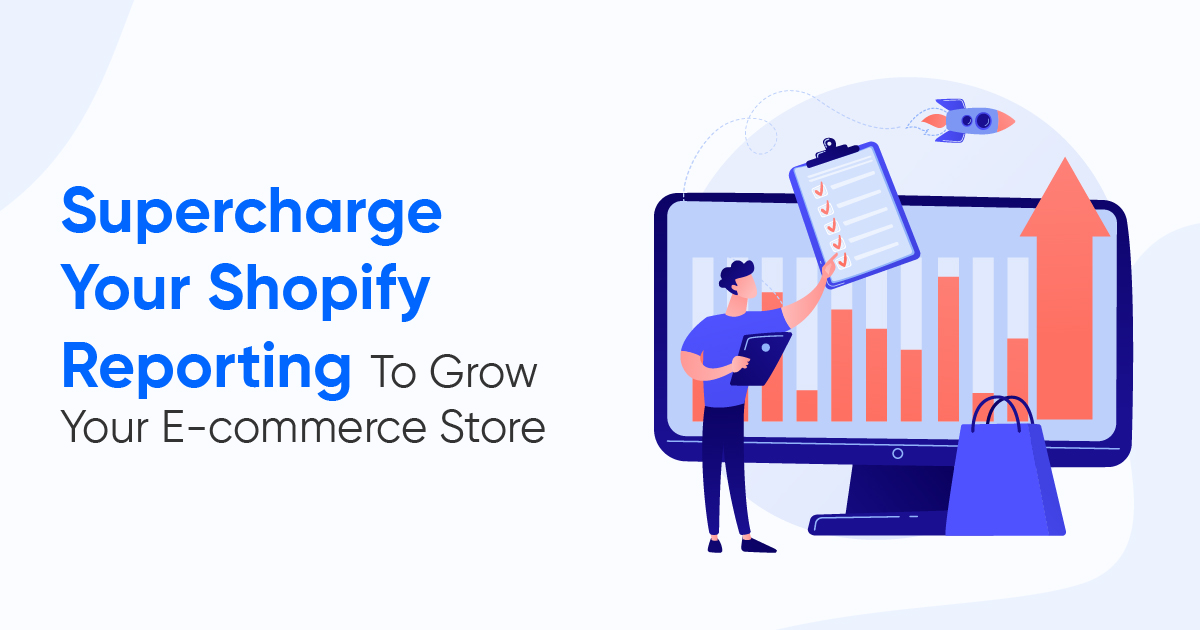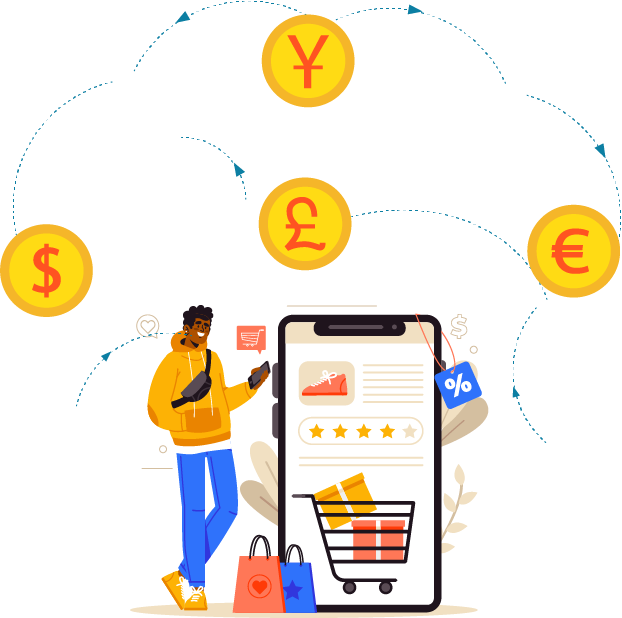Supercharge Your Shopify Reporting To Grow Your E-commerce Store

Shopify’s platform makes it easy for e-commerce merchants to showcase their products and sell them at profitable prices. However, Shopify’s in-house tools for business growth, such as Shopify Reporting, do not fully meet the business requirements of the e-commerce merchant.
While Shopify Reporting is useful for stores just starting on the e-commerce marketplace, sellers looking to grow online sales will need customized reporting solutions to make sense of the massive amounts of data that are generated.
Shopify Reporting
Shopify Reporting is an essential part of Shopify’s e-commerce operations that helps merchants track their sales progress and success. Shopify’s data for sales and revenue can be used as they are for extracting actionable insights and making informed business decisions.
Events like site visitors originating from UTMs can be accurately recorded session-wise along with the UTMs. Also, Shopify is good at identifying the source of referral traffic which is the last site your users were on before visiting your online shop.
While this reporting is sufficient for certain aspects of sales and revenue, it is inadequate due to various factors which we will discuss here.
How to Enhance Shopify Reporting
While Shopify is a great platform for businesses of all sizes to run their e-commerce enterprise, when it comes to its reporting capabilities, in certain cases, you will need third-party applications that provide additional reporting capabilities. We will explore these aspects of Shopify:
1. Customized Shopify Reports
Shopify reporting provides a wide range of reports for e-commerce merchants to drill down into their store data and implement business decisions backed by data-driven insights. Most Shopify reports are in the format of Sales and Order reports along with transaction reports.
However, e-commerce merchants will require reports with data fields across categories such as sales, fulfillment, customers, transactions, and much more. In these cases, you will need custom reporting to meet business needs.
A feature unique to Report Pundit is that you can mix and match various report categories and fields to get the report you need. For example, you can combine Fulfillment, Sales, Transactions, Customers, and more, to get a truly customized report that matches your niche requirements. This means that even if it is a sales report, you can run the same report based on fulfillment, transactions, or other essential details.
Another unique use case of Report Pundit involves extracting the dates that might be saved in note attributes, order tags, or metafields. This will be reformatted into a new report with other required report categories and fields.
2. Tax Reports
Shopify’s Reporting displays values for metrics such as shipping and discounts that are reported after taxes. In case you need the amounts for discounts and shipping before taxes you might need custom reports from third-party applications that can be changed according to requirements.
The tax data that you can extract from Shopify for tax purposes include location details such as Country and State/Province, order subtotal with or without tax, order fulfillment status and date along with customer information.
While the location indicates the tax liability of the store, the order total with and without tax includes the price the customer paid excluding sales and shipping tax. Also, the fulfillment details let you know when the order was fulfilled, along with the payment date.
The customer information includes fundamental details of the person including name, email, shipping address, and so on.
Problems with Shopify Tax Details
The major issue with Shopify Tax Collection is that Shopify as a platform doesn’t let one connect and automate data points.
This means e-commerce merchants won’t know when they have crossed destination-based thresholds for tax. This is especially a concern when merchants are selling between various regions of the same country or between countries. Such a situation poses a challenge in that you won’t be able to see tax liabilities according to the geographical region.
Shopify tax calculations will not include refunds and the merchant may or may not return the sales tax depending on the time taken to return the order.
Another essential detail that Shopify Reporting does not provide includes the taxable and non-taxable amounts per transaction. Even if the Shipping Tax data is included in Shopify Reporting it does not include the breakup of the amount or even the import tax data. This is a critical data point that merchants will need to analyze their tax liability and compliance.
You can solve the problem of inaccurate Tax Reports using Report Pundit’s Tax Reports that ensure compliance with tax regulations. With the Total Tax Report by Country, you can calculate taxes collected, and with the Taxable and Non-Taxable Sales Report, you can identify taxable transactions. You can also navigate complex tax structures through reports such as the Multi-Level Tax Report and the Shipping Tax Report.
3. Combine Shopify data with data from other apps
Shopify provides a host of integrations ranging from marketing to fulfillment and a whole lot more. Whether it is Ad platforms such as Google, Bing, and Amazon Ads or applications for Return Management such as Return Prime and Loop Returns, e-commerce merchants will require consolidated reporting for all these applications.
Report Pundit’s integrations span everything from marketing, payout reports, and subscriptions, to Shipping and Returns. This means you can access data from every touchpoint on the e-commerce customer journey. E-commerce merchants can tap into detailed reports from these integrations, making use of consolidated reports to draw actionable insights from the consolidated report data.
You can combine data from the integrated apps with data from Shopify to get detailed reports that are unique and only available through third-party applications like Report Pundit.
4. Multi-Store Consolidated Reports
While Shopify provides significant reporting features for individual stores, it does not currently offer a built-in solution for consolidated reporting across multiple stores.
The closest thing available to merchants for multiple stores is Shopify’s multi-store POS which can be used to conduct e-commerce operations across geographical locations.

However, e-commerce merchants who need a solution to Multi-Store Reporting can adopt third-party applications that provide reliable Multi-Store Reporting across time zones. Report Pundit is one such application that helps e-commerce merchants view all reporting information in a single dashboard.
In case you are an e-commerce merchant with more than one online store then you can get our Multi-Store Reporting which can display data across stores on a single dashboard.
5. Payment Currency Reports
An important aspect of the Shopify ecosystem is the checkout currency for sales metrics. This refers to the currency the customers use to pay for their purchases and is essential for merchants.

Shopify does come with a very useful multi-currency feature that works except for preset and fixed-price bundles, certain subscription widgets, payment methods (Braintree Payments), and subscription management processes.
However, with Report Pundit, you can overcome the limitations you might face with Shopify’s platform concerning presentment currency. You will be able to get a detailed report of customer spending for all requirements in the form of detailed reports as required by your e-commerce business.
Meet Your Reporting Needs with Report Pundit
As discussed earlier, Shopify Reporting is limited when it comes to reporting according to specific business needs. This is where Report Pundit can help. We extract data through the Shopify API to generate accurate custom reports that fulfill your business requirements.
If you intend to go beyond the offerings of Shopify Reporting then the right third-party app can help dig into your e-commerce data and uncover actionable insights that help make smarter business decisions.
You can learn more about how you can overcome the limitations of Shopify Reporting by checking out A List of Top Shopify Reports Preferred by Store Owners.
